Content
Published:
This is an archived release.
Less youth exposed
In 2012, 17 per cent of 16-24 year-olds reported having been the victim of one or more incidents of theft, criminal damage, violence or threats of violence during the last year. This share is considerately lower than in all of the five previous surveys in the period 1991-2007 where these factors are mapped.
| 2001 | 2004 | 2007 | 2012 | |
|---|---|---|---|---|
| Corrected 24 June 2016. | ||||
| Exposed to violence or threats of violence last 12 months, total | 5.0 | 5.1 | 5.5 | 4.3 |
| Exposed to theft or criminal damage last 12 months | 10.0 | 11.8 | 10.1 | 8.0 |
| Feared violence or threats in their home area recently | 7.9 | 7.9 | 6.7 | 7.3 |
| Feared thefts or criminal damage recently | 14.2 | 14.3 | 10.5 | 10.3 |
| Number of respondents | 3 250 | 3 340 | 3 212 | 6 186 |
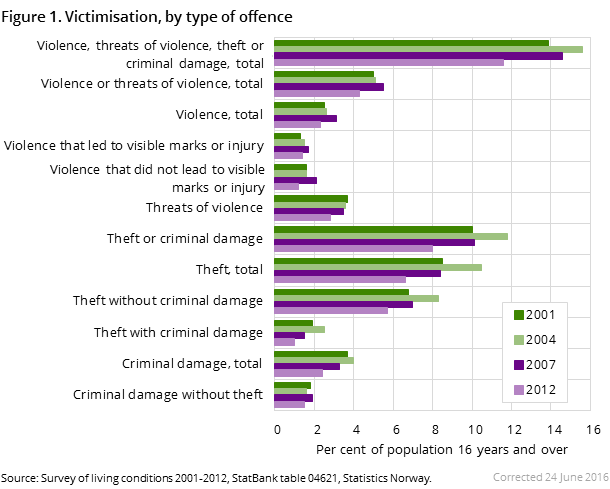
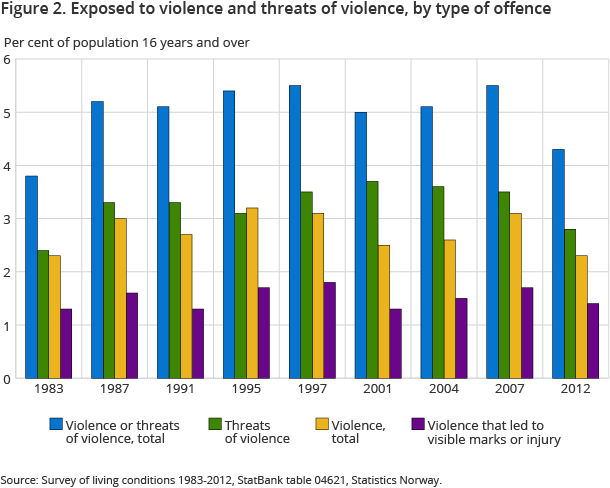
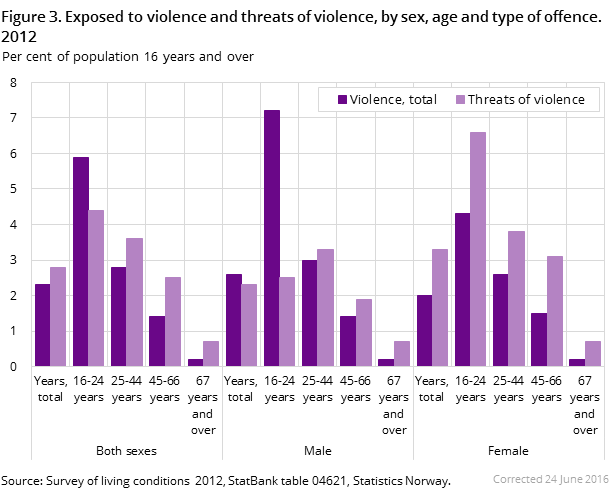
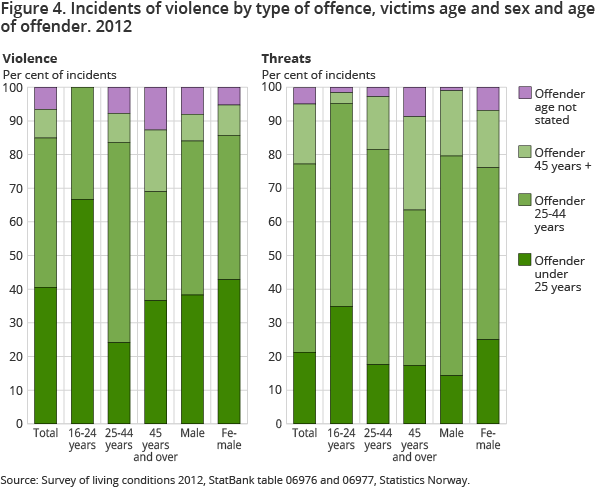
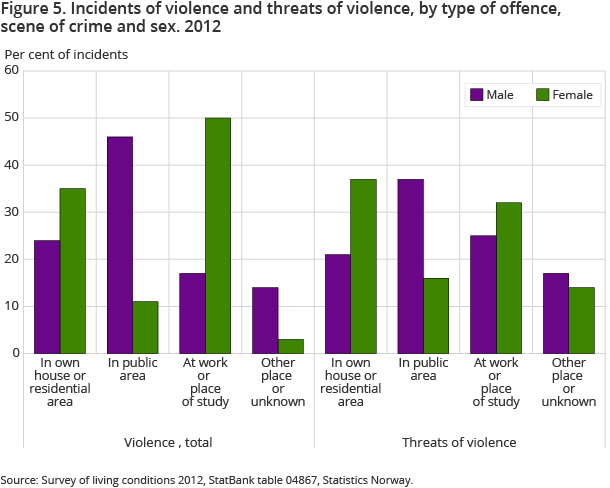
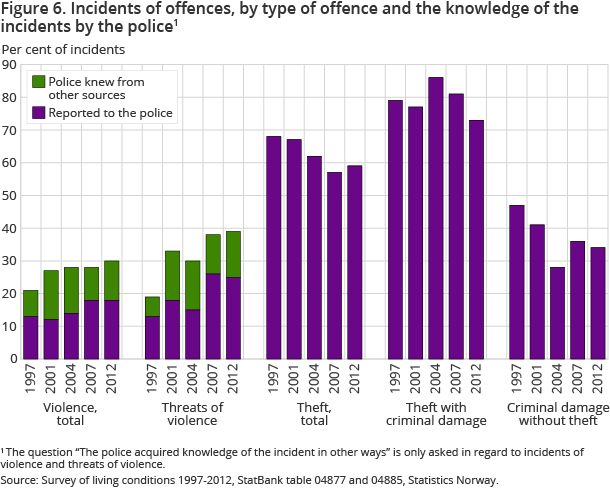
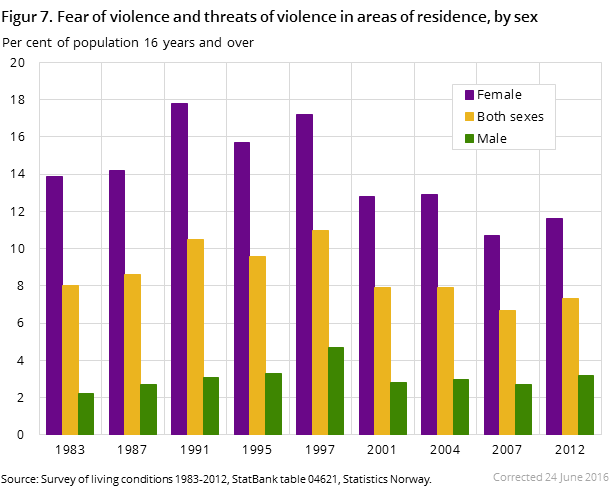
The survey of living conditions which was carried out in the first half of 2012 shows that 11.6 per cent of the population aged 16 years and over were the victim of one or more incidents of violence, threats of violence or criminal damage during the last year. This is significantly lower than the 14-16 per cent reported in the previous three surveys – in 2001, 2004 and 2007. Looking further back, the fear in the adult population for these kinds of crimes in 1991 and 1997 was even higher, as much as 17 per cent.
Further decline in the victims of theft and criminal damage
The fall in exposure to crime shown in the surveys of living conditions over the last 20 years correlates mainly with a decline in the victims of theft and criminal damage. In 2012, 8 per cent of respondents reported being the victim of theft or criminal damage during the last year. Thus, this share is further reduced from the last survey in 2007, where the share was 10 per cent. Corresponding general trends both for longer and shorter reference periods, are also visible in the statistics for offences reported to the police and the victims of these offences.
From 2007 to 2012 there was a particularly large decline in the share of the population who are victims of theft. The reduction is particularly large for those in the age group 16-24 years, and this decline was approximately equally large for both women and men in this age group. In 2012, men in the age group 25-44 years has the highest share who are exposed to theft, with 10 per cent. Young women in the age group 16-24 years are second most exposed, with a share of just over 9 per cent.
Now also smaller share of victims of violence and threats of violence
From 2007 to 2012 there was a significant decline in most types of reported offences (see figure 1). In 2012, 4.3 per cent of the population aged 16 years and older reported being the victim of one or more incidents of violence or threats of violence. This is a significantly smaller share than in all of the surveys in the period 1987-2007, and the share of the population reporting to be the victim of physical violence is just as low in 2012 as in 1983 – with a share of 2.3 per cent (see figure 2).
Young males and females – not adults - considerably less exposed than in 2007
In 2007, there was a particularly high share of youth aged 16-24 years, especially among males, reporting to be the victim of physical violence. In the 2012 survey, however, these shares are significantly lower. Compared to 2007, the share of young males exposed to violence is halved, from just over 14 per cent to 7 per cent, while for females in the same age group the share is reduced by one third, from over 6 per cent to just over 4 per cent.
Furthermore, in the 2012 survey there is a very low share of young males, and also somewhat fewer young females, who report being exposed to violence during the last year. Thus, in 2012 it is even clearer that young females are more exposed to violence than young males. For all of the older age groups, both for males and females and for both violence and threats of violence, there are either small or no changes from 2007-2012.
Youth still most exposed to violence
The risk of being exposed to violence has a clear correlation with age. In all of the surveys of living conditions, there are far larger shares of victims of violence among youth than among older age groups – both for males and females. The survey of 2012 shows that 6 per cent of the population in the age group 16-24 years have been exposed to violence during the last year, which is especially significant for males. The older the person is, the greater the risk of being the victim of violence, and among those aged 67 years and older, the 2012 survey shows very few victims of violence (see figure 3).
Many victims exposed more than once
Those exposed to violence or threats of violence are comparatively often exposed more than once. In the last survey, an average of 2.2 incidents of violence or threats of violence are reported for each of these victims. Repeated exposure is more frequent for female victims than for male victims, with an average of 2.5 and 1.9 incidents of violence and threats of violence respectively during a year.
Almost always male offenders, but also some female
In total, there was a male offender in over 80 per cent of all incidents of violence and threats of violence. Out of all cases of physical violence against victims aged 16-24 years, as many as nine out of ten had a male offender. Also, correspondingly large shares of offenders are male in cases of threats of violence against males, as well as against persons aged 25-44 years. In 2012, females are the offenders in more than one fifth of all incidents of violence against females, and in an almost equally large proportion of violent incidents against adults aged 25 years and older.
Summed up, offenders under the age of 25 years are behind 40 per cent of all incidents of violence, and for violence against victims aged 16-24 years; two out of three offenders are under the age of 25 years. Young adults aged 25-44 years, however, constitute an even larger share of offenders in violent incidents; 44 per cent. The offender is aged 25-44 years in half of the cases of threats of violence against females, and in two thirds of all threats of violence against males (see figure 4).
Males and females victims of different types of violence
The survey of living conditions in 2012, as in most of the previous surveys, shows certain significant differences in the types of violence males and females are exposed to. Males are far more often exposed to violence in public places at night by an intoxicated offender. In half of the incidents of violence against men the offender is also unknown. A far greater share of the violence against women happens at work or in residential areas, and by non-intoxicated offenders.
That employed women are exposed to more violence and threats of violence than employed men, is a fact known through the survey on working environments. However, half of all violent incidents against women happened at work or place of study, which is a far greater share than in previous years (see figure 5).
Violence and threats of violence more frequent than theft
Victims of theft or criminal damage are rarely exposed to these kinds of offences more than once during a year, and in 2012 these victims were exposed to 1.2 incidents of theft or criminal damage. Thus, the last survey of living conditions shows an equal number of violence and threats of violence as theft or criminal damage. Some of these incidents are criminal damage without theft, and from this survey of the adult population we can deduce that incidents of violence or threats of violence happen more often than theft overall.
Equal share of incidents as in 2007 reported to the police
Out of all incidents of violence or threats of violence in the survey of living conditions in 2012, the police had knowledge of 35 per cent. This is a slightly higher share than in the previous, comparable surveys. Compared to earlier years, shares of these incidents reported to the police were higher in 2007 and 2012, making up 18 per cent of all incidents of violence and a quarter of all threats of violence.
In Norway, private citizens report far more thefts than violent offences to the police According to the survey in 2012, 59 per cent of all thefts are reported to the police, which is about the same share as in 2007. Thefts with criminal damage mainly happen to cars and residences, and 73 per cent of these incidents were reported to the police in 2012. That these kinds of thefts make up a significantly smaller share of all thefts than in previous years, from 40 per cent in 1991 to 15 per cent in 2012, is one of the main explanations for the fact that the police’s registered report rate has declined during this period of time (see figure 6).
Young females experience most fear of violence in areas of residence
In all of the surveys of living conditions, there are far more females than males who report experiencing fear of violence in their residential area. From the 2012 survey, nearly 12 per cent of the females had recently experienced situations in their residential area that provoked fear of violence and threats of violence. This is about the same share as in 2007. The continued decline in females’ fear of violence in earlier surveys was therefor not extended in the 2012 survey (see figure 7).
In 2012, over 22 per cent of all females aged 16-24 years had recently experienced fear of being exposed to violence and threats of violence. Among males in the same age group, the share was 5 per cent. Differing from previous surveys, especially from those in the earliest decades of this survey, there is now a relatively clear correlation between age and fear of violence and threats of violence – both for females and males. The lower the age, the larger the share that experiences situations in their residential area that provoke fear of violence and threats of violence. Even though there is still a large disparity between females and males, it is now far more obvious that fear of violence is most usual among the age groups that are also most exposed to violence.
One out of ten troubled by theft and criminal damage
In the five surveys in the period 1997-2012, the population is asked whether they recently have experienced fear of being exposed to theft or criminal damage. During these years, this share has been more than halved. As in 2007, 10 per cent reported in the last survey to have been very or a little troubled by theft or criminal damage, a share which is relatively equal in all age groups and for both males and females.
Survey of living conditions, now with a larger sampleOpen and readClose
The surveys of living conditions in 1983, 1987, 1991, 1995, 1997, 2001, 2004, 2007 and 2012 included questions about the population’s victimisation and fear of crime during a year. The first eight surveys operated with a representative gross sample of 5 000 persons in the population aged 16 years and over, where the response rate in the first four surveys was between 75 and 78 per cent, and the four last surveys between 66 and 70 per cent. In 2012, the sample was considerately larger, consisting of a total of 11 387 persons aged 16 years and over. In total, 6 186 persons responded to the survey, equalling a response rate of 55.6 per cent. See also About the statistics and documentation note (Norwegian only) for each of the surveys.
Survey of living conditions on victimisation and fear of crime, 1983-2012Open and readClose
In all of the nine surveys, the population is asked about their victimisation and fear of violence and threats. In six of the surveys, up to six incidents of violence and threats are mapped with type of scene of crime and time of crime, contact with police and medical professionals, as well as relation to the perpetrator and the perpetrators intoxication. In the two previous surveys, the sex and age of the perpetrator is also included. In the last five surveys, and in 1991, the respondents are asked about victimisation from theft and criminal damage – including questions regarding scene of crime, time of year, value of the stolen or damaged items and whether the incident was reported to the police. Furthermore, in the previous five surveys, all respondents are also asked about the fear of being the victim of theft and criminal damage.
Find more figures
Find detailed figures from Victimisation and fear of crime, survey on living conditions
Additional information
Read more about the execution of the last survey in the documentation note (Norwegian only):
Contact
-
Reid Jone Stene
E-mail: reid.jone.stene@ssb.no
tel.: (+47) 99 02 22 01
